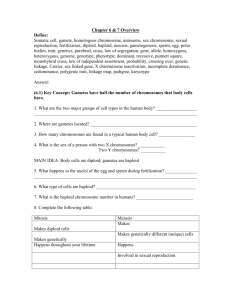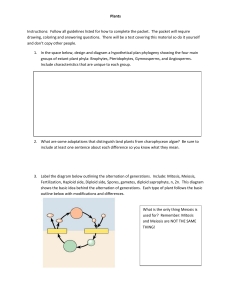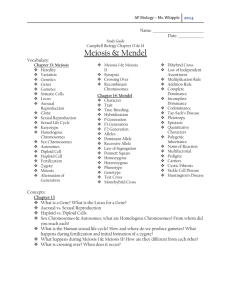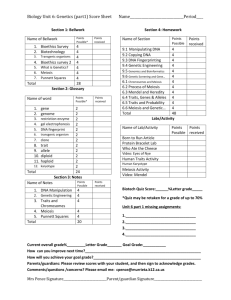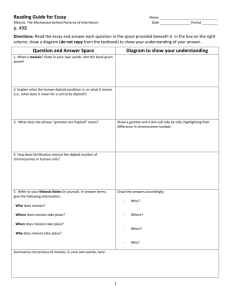Biology Chapter 11: Homework Hmwrk 11
advertisement
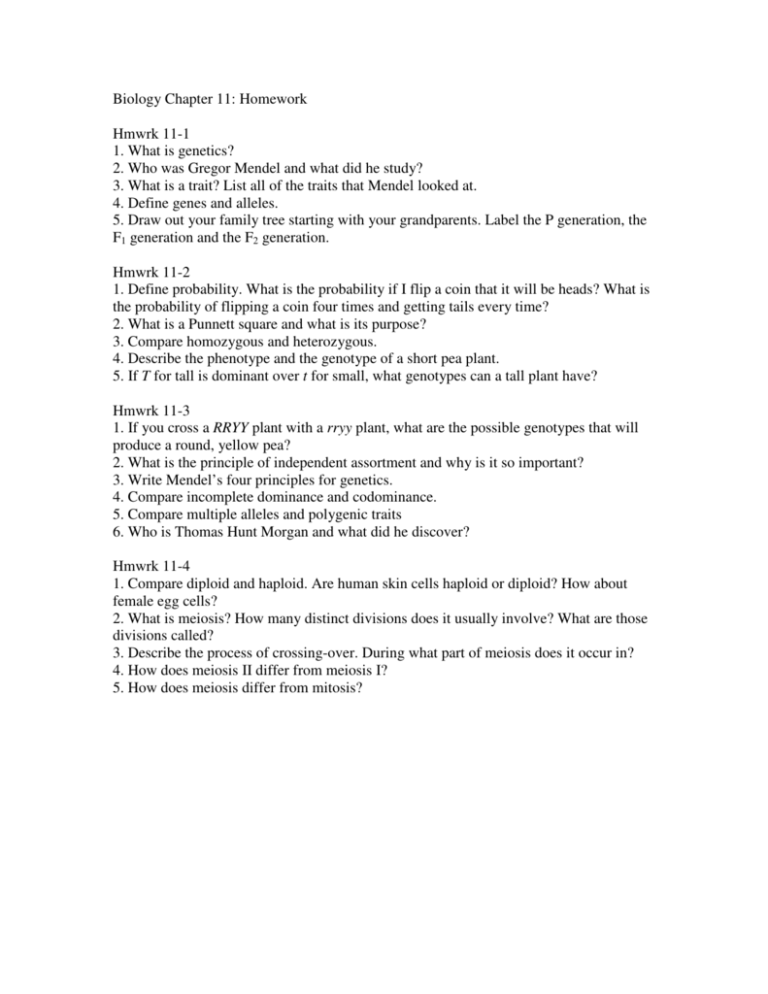
Biology Chapter 11: Homework Hmwrk 11-1 1. What is genetics? 2. Who was Gregor Mendel and what did he study? 3. What is a trait? List all of the traits that Mendel looked at. 4. Define genes and alleles. 5. Draw out your family tree starting with your grandparents. Label the P generation, the F1 generation and the F2 generation. Hmwrk 11-2 1. Define probability. What is the probability if I flip a coin that it will be heads? What is the probability of flipping a coin four times and getting tails every time? 2. What is a Punnett square and what is its purpose? 3. Compare homozygous and heterozygous. 4. Describe the phenotype and the genotype of a short pea plant. 5. If T for tall is dominant over t for small, what genotypes can a tall plant have? Hmwrk 11-3 1. If you cross a RRYY plant with a rryy plant, what are the possible genotypes that will produce a round, yellow pea? 2. What is the principle of independent assortment and why is it so important? 3. Write Mendel’s four principles for genetics. 4. Compare incomplete dominance and codominance. 5. Compare multiple alleles and polygenic traits 6. Who is Thomas Hunt Morgan and what did he discover? Hmwrk 11-4 1. Compare diploid and haploid. Are human skin cells haploid or diploid? How about female egg cells? 2. What is meiosis? How many distinct divisions does it usually involve? What are those divisions called? 3. Describe the process of crossing-over. During what part of meiosis does it occur in? 4. How does meiosis II differ from meiosis I? 5. How does meiosis differ from mitosis? Biology Chapter 11: Study Guide Section 1 • Definitions Genetics Trait Allele Fertilization Hybrid Segregation True-breeding Gene Gamete • Know who Gregor Mendel is, what is considered the father of and what he studied • Be able to determine if a plant is a true-breeding plant • Know the traits that Mendel studied as well as the alleles • Know the names of each generation (i.e. P, F1, F2, F3 generation, etc) • Be able to determine if a plant is a hybrid • Be able to describe the process of segregation and what it means • Know what gametes are and what they contain Section 2 • Definitions Probability Homozygous Phenotype Punnett square Heterozygous Genotype • Be able to determine the probability of a situation (i.e. calculate) • Know what a Punnett square is and how to use it • Be able to determine if an individual is homozygous or heterozygous by looking at the genotype • Be able to determine the phenotype from a genotype and vice versa • Be able to determine the expected outcome of a cross using probability • Know that a larger number of offspring means the predicted results will mirror the actual results Section 3 • Definitions Independent assortment Codominance Polygenic traits Incomplete dominance Multiple alleles • Be able to do a two-factor cross (i.e. a cross with two traits) • Be able to determine the expected outcome of a cross using probability • Know what independent assortment is and why it is important • Know Mendel’s principles • Be able to compare complete dominance, incomplete dominance, codominance, multiple alleles and polygenic traits • Be able to determine the pattern of inheritance if given a family tree • Know who Thomas Hunt Morgan is and what he did for the field of genetics • Know the phrase “nature v. nurture” and its flaws Section 4 • Definitions Homologous Haploid Tetrad Diploid Meiosis Crossing-over • Know what the two things are that Mendel’s principles require • Be able to determine which sets of chromosomes are homologous • Know what haploid and diploid are and what types of cells are haploid and diploid • Know what meiosis is and what its purpose is • Know what happens in each division of meiosis (i.e. meiosis I and II) • Be able to describe the process of crossing-over and its purpose • Be able to recognize diagrams of meiosis and know what the step is • Know what type of gamete is produced by a female and a male • Know how the production of female gametes differs from male gametes • Be able to compare mitosis and meiosis Section 5 *** I have decided to delete this section from the exam.


